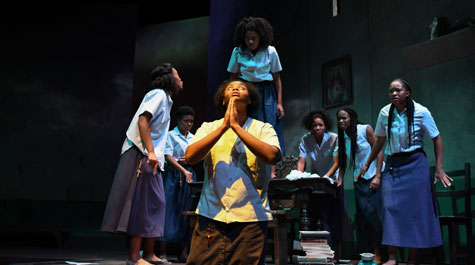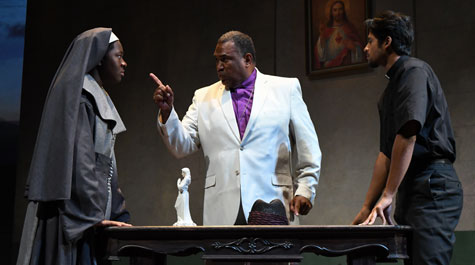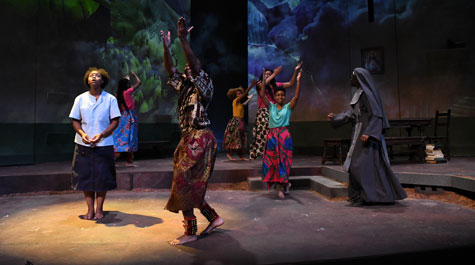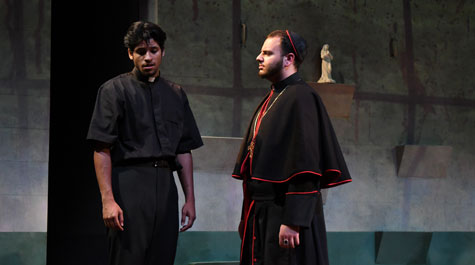Audience discusses 'Our Lady of Kibeho' with cast, collaborators
Themes of faith, race and gender were among those discussed as the cast, designers and other collaborators of William & Mary theatre’s “Our Lady of Kibeho” took audience questions following Saturday night’s performance at Phi Beta Kappa Memorial Hall.
The play, written by Katori Hall and marking the W&M directorial debut of Assistant Professor of World Theatre Claire Pamment, is based on a true story. It was proposed by Artisia Green, associate professor of theatre and Africana studies and program director of Africana studies, and selected for its themes about the oppressive legacies of colonization and the perceived ownership of God as part of W&M’s 50th anniversary commemoration of its first African-American residential students, according to Pamment.
The plot takes place in 1981 pre-genocidal Rwanda and centers on an all-girls Catholic school where student Alphonsine claims to have seen the Virgin Mary. She is initially disbelieved, ostracized and scolded, but when classmate Anathalie also witnesses the visions, everyone involved starts to explore faith, fear and doubt. Three students eventually saw visions foretelling extreme violence in Africa prior to the ethnic bloodshed between the Hutu and Tutsi factions that took place in 1994.
“It’s an interesting parallel to look at the historical context of this show with regards to our 50th anniversary celebration that we’re having right now for the three African-American women who were the first African-Americans to live on this campus, in the basement of Jefferson — just thinking about the kind of struggles that they were having to face, the types of things that they probably had to overcome at the time in the 1960s,” said Alana Canty-Samuel ’18, who played the lead role of Alphonsine.
As the show’s characters try to understand, trust and listen to one another, their individual issues, biases and stereotypes are examined. These encompass male-female, Hutu-Tutsi and student-authority figure relationships, including the girls’ adulation of male school leader Father Tuyishime, combativeness with top female school leader Sister Evangelique and their prevailing relationship with the Virgin Mary.
“It’s easy to relate to a character, a black girl, who isn’t being listened to by the established power,” said Arika Thames ’19, who played one of the three visionary students, Anathalie.
“I think we can all kind of see that in our lives today even, at this school, in this country.”
Michael Alvarez ’20 played the villainous role of Father Flavia, a racist Italian priest who is sent from the Vatican to investigate the girls’ visions, which he does not believe are authentic. Alvarez said he tried to focus on his character’s love for the Vatican and the progress he makes, leaving the village of Kibeho still having prejudices but recognizing that he has them.
“That was one way I was able to, not 100 percent sympathize with the character, but understand where he’s coming from — not with the racist aspects of it, but why he’s so driven in this,” Alvarez said.
The main characters are set up as archetypes to illustrate the themes, with the script filling in the gaps where details are unknown, said Horace Smith, a Colonial Williamsburg interpreter who played both the Bishop of Kibeho and Anathalie’s father.
“A lot of this deals with the idea of who gets to be the voice of God,” Smith said. “Can an orphan girl from Africa have a message from the heavens? Can the Pope in Rome have the last say on what the will of God is?
“... Who can have the last word on what the creator of the universe has to say to us?”
The story illustrates the very human aspect of who each character is and that they can still be spoken through, said Xavier Soto-Burgos ’20, who played Father Tuyishime.
“They’re not perfect people,” he said, as illustrated by Alphonsine’s portrayal as a struggling student with a crush on his character.
“You don’t have to be special to be chosen.”
 Skip to main content
Skip to main content




